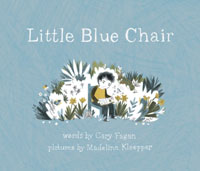| ________________
CM . . .
. Volume XXIII Number 24. . . .March 3, 2017
excerpt:
There are simple things in life that we use every day, such as chairs, that we often take for granted. This endearing story is about the journey of a chair who passes through the possession of various owners. In the beginning, the little blue chair belongs to a young boy named Boo. He delighted in taking the chair with him everywhere he went. To Boo, the chair was much more than just a place to sit: it was the tip of the tent when he played outdoors, it was a stool when he wanted to boost his height, and it even became a pillow at times when he fell asleep. Once Boo outgrew his chair, his mother discarded the item by leaving it at the end of their driveway with a note that read: PLEASE TAKE ME. The little blue chair ends up in a junk shop, and from there it is passed on to a string of owners who each use the little blue chair to serve a new purpose. When the owners decide that they no longer need the chair, they, too, offer it up in a similar way to that of Boo’s mother: with a sign for somebody else to make use of it. In the end, the chair literally lands on Boo’s front doorstep. At this point, Boo is a grown man with a child of his own. Quickly recognizing that this is the chair he once adored as a child, Boo revives the visibly used chair and gives it a new life. Following the repairs, Boo gifts the refurbished little blue chair to his young daughter, Belle, who loves the chair as he did.
Recommended. Andrea Boyd is an early years educator who recently graduated from the University of Manitoba. She currently teaches Grade 4 in Winnipeg, MB.
To comment
on this title or this review, send mail to cm@umanitoba.ca.
Copyright © the Manitoba Library Association. Reproduction for personal
use is permitted only if this copyright notice is maintained. Any
other reproduction is prohibited without permission.
Next Review | Table of Contents For This Issue - March 3, 2017 |
